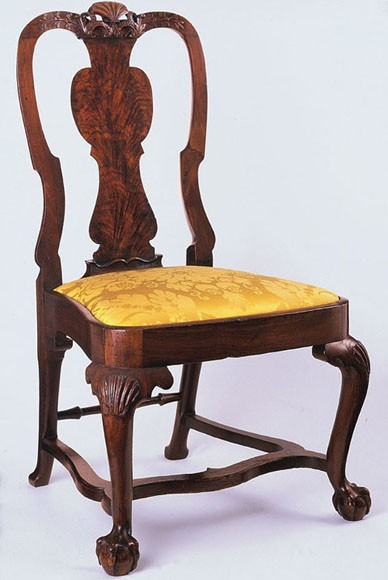
Side chair with carvings attributed to John Welch, Boston, ca. 1735. Walnut and walnut veneer with maple and white pine; maple slip seat. H. 38 5/8", W. 20 3/4", D. 18 1/2". (Courtesy, The Metropolitan Museum of Art, gift of Mr. and Mrs. Benjamin Ginsburg, 1984 (1984.21) All rights reserved, The Metropolitan Museum of Art; photo, Gavin Ashworth.)
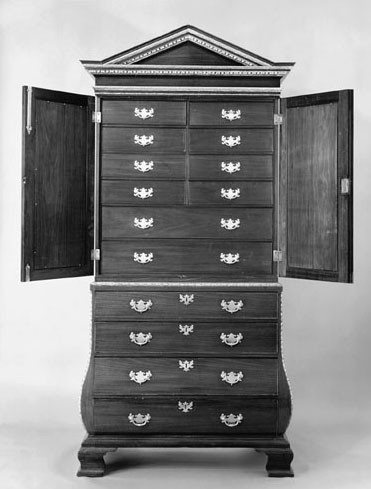
Bureau with cabinet, London, 1740–1750. Mahogany, partially gilded, mahogany veneered on oak, deal, brass.. H. 97", W. 46 3/4", D. 25 1/2". (Courtesy, Museum of Fine Arts, Boston. Reproduced with permission. ©2000 Museum of Fine Arts, Boston. All rights reserved. Gift of Albert Sack.) This bureau is related to case pieces attributed to the shop of London cabinetmaker Giles Grendy, one of the leading exporters of furniture.

Side chair, London, 1725–1735. Walnut and walnut veneer. (Photograph Courtesy of Sotheby’s, Inc. ©2002)

John Singleton Copley, Jeremiah Lee, Boston, ca. 1770. Oil on canvas. Frame attributed to John Welch, Boston, ca. 1767. White pine, gilded. Portrait dimensions: 95" x 59". (Courtesy, Wadsworth Atheneum, Ella Gallup Sumner and Mary Catlin Sumner Collection Fund.)

Detail of the crest rail carving on the side chair illustrated in fig. 1. (Courtesy, The Metropolitan Museum of Art, gift of Mr. and Mrs. Benjamin Ginsburg, 1984; All rights reserved, The Metropolitan Museum of Art; photo, Gavin Ashworth.)

Detail of the shell and acanthus carving on the frame illustrated in fig. 4.
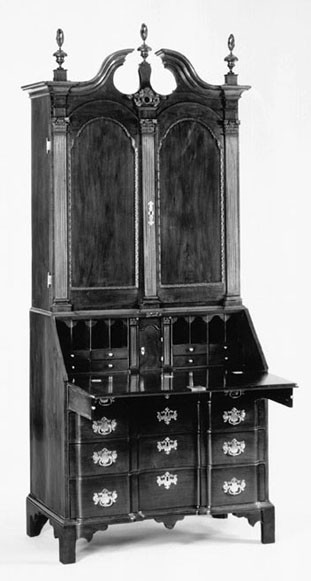
Desk-and-bookcase with carving attributed to John Welch, Boston, 1750–1755. Mahogany with white pine. H. 95 1/2", W. 40", D. 22". (Courtesy, Saint Louis Art Museum, Museum Shop Fund; photo, Christie’s.)
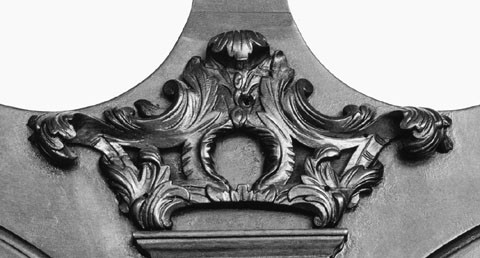
Detail of the scrollboard appliqué of the desk-and-bookcase illustrated in fig. 7. (Photo, Christie’s.)
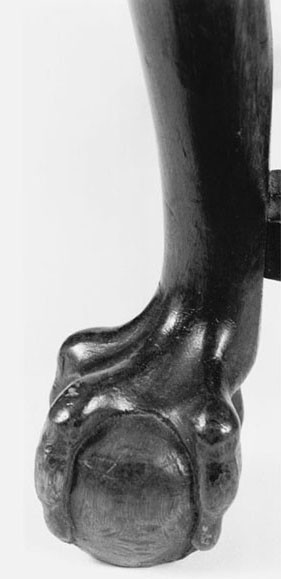
Detail of the foot of the side chair illustrated in fig. 1. (Courtesy, The Metropolitan Museum of Art, gift of Mr. and Mrs. Benjamin Ginsburg, 1984; All right reserved, The Metropolitan Museum of Art; photo, Gavin Ashworth.)

Diagram of (a) diagonal orientation with foot placed in center of stock and toes at corners; (b) diagonal orientation but with foot placed at front corner; (c) frontal orientation with knee blocks on opposite sides (see legs of turret table illustrated in fig. 13). (Drawing, Alan Miller; artwork, Wynne Patterson.)

Card table with carving attributed to John Welch, Boston, 1730–1740. Mahogany with white pine. H. 28 3/4", W. 31 3/4", D. 16". (Private collection; photo, Wit McKay.) A label in the table reads, “1906 . . . This . . . card table belonged to Peter Roe Dalton, Jnr. . . . Descended to his son Peter Roe, Jnr., was in his house-72 Boylston Street.” A Boston bombé chest descended in the same family.

Detail of the foot of the card table illustrated in fig. 11. (Photo, Wit McKay.)

Card table with carving attributed to John Welch, Boston, 1740–1755. (Private collection; courtesy, John Walton Antiques.) This card table has claw-and-ball feet that are very similar to those of the chair illustrated in fig. 16. These feet are typical of those produced in Welch’s shop during the 1740s and early 1750s.
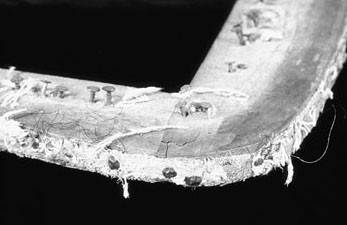
Detail of the slip seat of a chair from the Apthorp suite.

Easy chair with carving attributed to John Welch, Boston, 1730–1740. Walnut and maple. H. 44", W. 31", D. 22". (Courtesy, Winterthur Museum.) The stretchers have a coved outer edge like those on the Apthorp chairs.

Side chair with carving attributed to John Welch, Boston, 1740–1750. Walnut and walnut veneer with maple and white pine; maple slip seat. H. 38 1/2", W. 22", D. 18 3/8". (Courtesy, Brooklyn Museum; photo, Gavin Ashworth.) The veneer on the splats of these chairs appears to be from the same flitch as those of the set including the chair illustrated in fig. 21.

Detail of the knee carving on the side chair illustrated in fig. 16. (Photo, Gavin Ashworth.)

Detail of the knee carving on the side chair illustrated in fig. 1. (Courtesy, The Metropolitan Museum of Art, gift of Mr. and Mrs. Benjamin Ginsburg, 1984; All rights reserved, The Metropolitan Museum of Art; photo, Gavin Ashworth.)
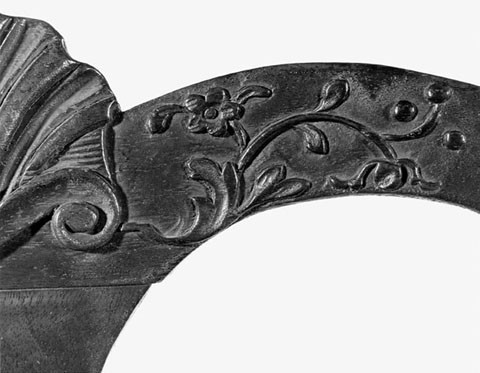
Detail of the crest rail carving on the side chair illustrated in fig. 16. (Photo, Gavin Ashworth.)
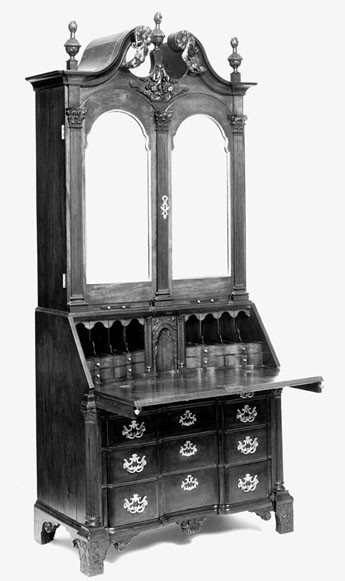
Desk-and-bookcase with carving attributed to John Welch, Boston, 1743–1748. Mahogany and sabicu with red cedar and white pine. H. 97 1/4", W. 42 7/8", D. 23 1/4". (Courtesy, Winterthur Museum.)
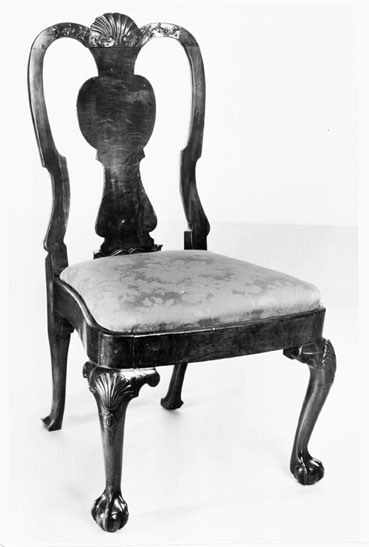
Side chair with carving attributed to John Welch, Boston, 1740–1750. Walnut and walnut veneer. H. 38", W. 20 1/2", D. 18 1/8". (Courtesy, Bernard & S. Dean Levy, Inc., NYC.)

High chest with carving attributed to John Welch, Boston, 1740–1750. Mahogany with white pine. H. 95 1/8", W. 41 1/4", D. 22 1/8". (Courtesy, Collection of Dorothy McIlvain Scott, Promised Gift to the Baltimore Museum of Art.)

Detail of the appliqué on the desk-and-bookcase illustrated in fig. 20.
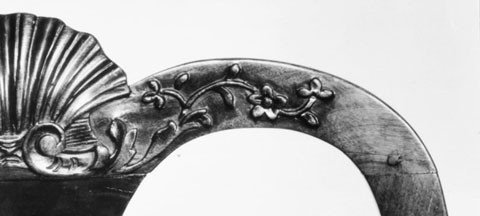
Detail of the crest rail carving on a chair from the same set as the chair illustrated in fig. 21. (Photograph Courtesy of Sotheby’s, Inc. ©2002.) The acanthus leaves emanate from the scroll volutes like those on the appliqué of the desk-and-bookcase illustrated in fig. 23. Both carvings have chip cuts in the scroll hollows and similar arrangement of the leaf elements.
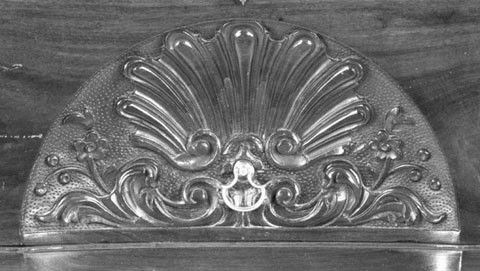
Detail of the lower drawer of the high chest illustrated in fig. 22.
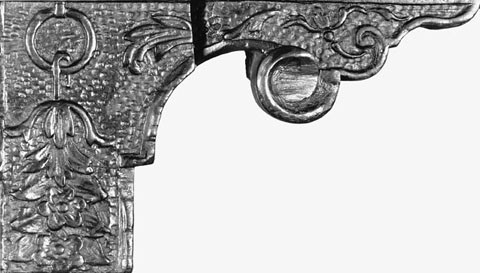
Detail of the foot of the desk-and-bookcase illustrated in fig. 20. The relief-carved husks (one rising from the edge beading and the other hanging from the loop) are products of the same design vocabulary, tool kit, and working style as the corresponding husks on the crest rails of the chairs illustrated in figs. 16 and 21 and the shell drawer illustrated in fig. 25.

Tall case clock with carving attributed to John Welch, Boston, 1750. Mahogany with white pine and courbaril. H. 100". (Courtesy, © The Art Institute of Chicago. All rights reserved. Alyce and Edwin DeCosta and Walter E. Heller Foundation and Harold Stuart Endowments; photo, Sotheby’s.)
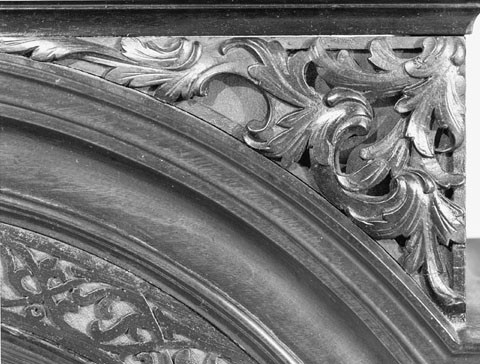
Detail of a spandrel appliqué on the tall clock case illustrated in fig. 27.

Side chair with carving attributed to John Welsh, Boston, 1735–1745. Walnut and walnut veneer with maple; maple slip seat. H. 39 1/2", W. 21 3/4". (Courtesy, Museum of the City of New York, gift of Mrs. Screven Lorillard.) www.mcny.org

Side chair with carvings attributed to John Welch, Boston, 1735–1745. Walnut with white pine; maple slip seat. H. 40", W. 20 1/2", D. 18 1/2". (Courtesy, The Metropolitan Museum of Art, Rogers Fund, 1925 (25.115.11) All rights reserved, The Metropolitan Museum of Art; photo, Gavin Ashworth.)
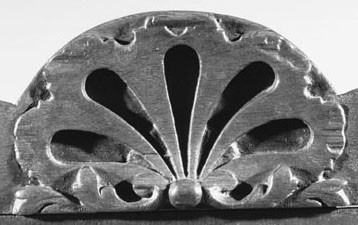
Detail of the crest rail carving on the side chair illustrated in fig. 30. The missing tips of the shell resembled those of the shell illustrated in fig. 32. (Courtesy, The Metropolitan Museum of Art, Rogers Fund, 1925 All rights rreserved, The Metropolitan Museum of Art; photo, Gavin Ashworth.)
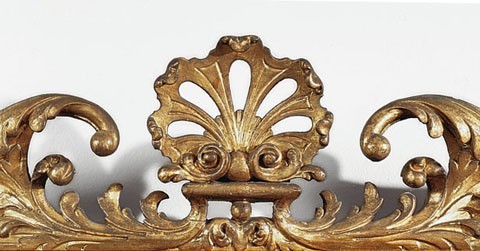
Detail of the applied shell and upper rail of a picture frame carved by John Welch for John Singleton Copley’s portrait of Isaac Smith, Boston, 1769. White pine, gilded. 58 1/2" x 48 1/4". (Courtesy, Yale University Art Gallery, gift of Maitland Fuller Griggs.)

Side chair, Boston, 1740–1750. Walnut and walnut veneer with maple and white pine. H. 38 5/8", W. 21 1/2", D. 21 1/4". (Courtesy, Diplomatic Reception Rooms, United States Department of State; photo, W.H. Brown)
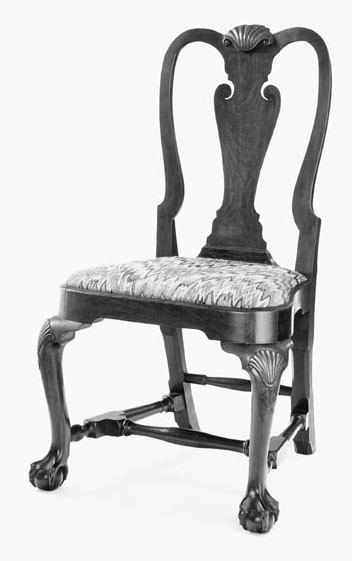
Side chair, Boston, 1740–1755. Mahogany; maple slip seat. H. 38 1/2", W. 22", D. 21 1/4". (Chipstone Foundation; photo, Gavin Ashworth.)

Settee, Boston, 1740–1755. Walnut with maple, birch, cherry, and walnut. H. 38", W. 65 5/8", D. 28". (Courtesy, Diplomatic Reception Rooms, United States Department of State.)
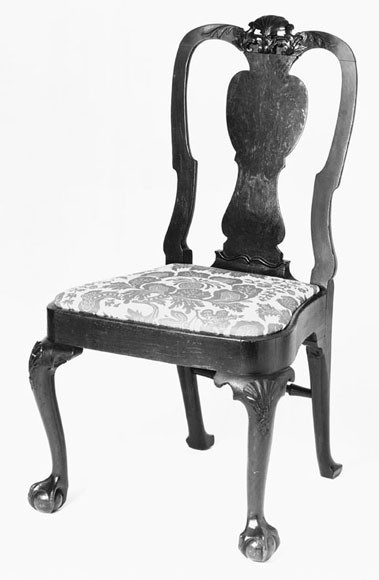
Side chair, Boston, 1735–1745. Walnut and walnut veneer with maple. H. 39", W. 20", D. 17 1/2". (Courtesy, Winterthur Museum.)
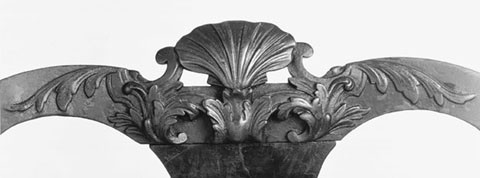
Detail of the crest rail carving on the side chair illustrated in fig. 36.
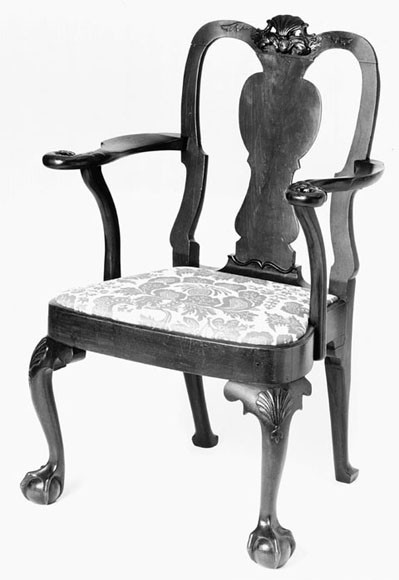
Armchair, New York, 1740–1755. Walnut; red gum slip seat. H. 39 1/2", W. 23", D. 19 5/8". (Courtesy, Winterthur Museum.)
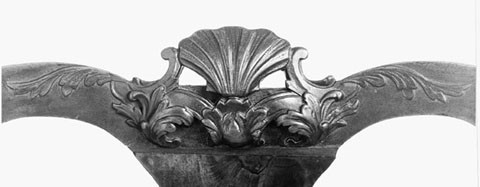
Detail of the crest rail carving on the armchair illustrated in fig. 38.

Side chair, New York, 1745–1760. Mahogany; oak slip seat. H. 38 3/4". (Collection of the Albany Institute of History and Art, gift of J. Townsend Lansing.)

Side chair, New York, 1745–1760. Mahogany; ash slip seat. H. 38 3/4", W. 21 1/2", D. 17 1/2". (Courtesy, Bernard & S. Dean Levy, Inc., NYC.)

Side chair, New York, 1745–1760. Mahogany; red oak slip seat. H. 39", W. 20", D. 17 1/2". (Courtesy, Winterthur Museum.)
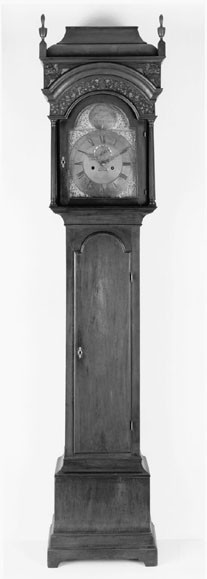
Tall clock case, Boston, 1740–1755. Movement by Thomas Claggett, Newport, 1740–1755. Materials and dimensions not recorded. (Private collection; photo, Gavin Ashworth.)
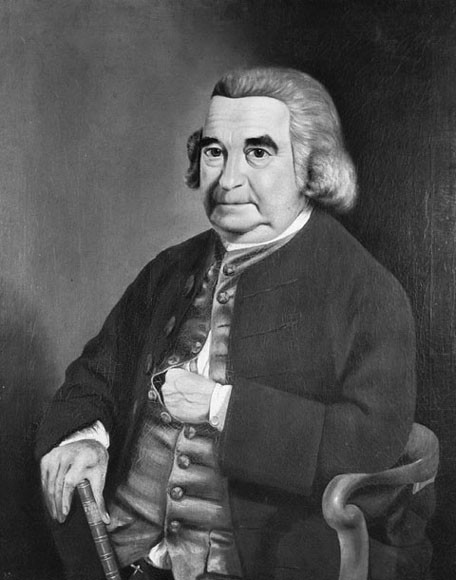
Abraham Redwood, attributed to Samuel King (1749–1819), Newport, ca. 1780. Oil on canvas. 42 1/2" x 33 1/2". (Courtesy, Redwood Library and Athenaeum, Newport, Rhode Island.) www.redwoodlibrary.org

Side chair, Boston, 1740–1755. Walnut. H. 38 3/4", W. 20 1/2". (Private collection; illustrated in The John Brown House Loan Exhibition of Rhode Island Furniture, 1965, pl. 8.)

Side chair, Newport, 1755–1775. Mahogany. H. 38 1/2", W. 20 1/2", D. 17 1/8". (Courtesy, Rhode Island Historical Society.)

Side chair attributed to John Goddard, Newport, 1760–1785. Mahogany and maple,. H. 39 5/8", W. 19 7/8", D. 16 1/4". (Courtesy, The Metropolitan Museum of Art; Rogers Fund, 1955.) (55.134). All rights reserved, The Metropolitan Museum of Art.
